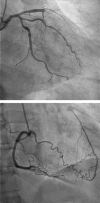Reduced coronary collateralization in type 2 diabetic patients with chronic total occlusion
- PMID: 29422093
- PMCID: PMC5804044
- DOI: 10.1186/s12933-018-0671-6
Reduced coronary collateralization in type 2 diabetic patients with chronic total occlusion
Abstract
Background: The extent of coronary collateral formation is a primary determinant of the severity of myocardial damage and mortality after coronary artery occlusion. Type 2 diabetes mellitus (T2DM) represents an important risk factor for impaired collateral vessel growth. However, the mechanism of reduced coronary collateralization in type 2 diabetic patients remains unclear.
Methods: With the reference to the recent researches, this review article describes the pathogenic effects of T2DM on collateral development and outlines possible clinical and biochemical markers associated with reduced coronary collateralization in type 2 diabetic patients with chronic total occlusion (CTO).
Results: Diffuse coronary atherosclerosis in T2DM reduces pressure gradient between collateral donor artery and collateral recipient one, limiting collateral vessel growth and function. An interaction between advanced glycation end-products and their receptor activates several intracellular signaling pathways, enhances oxidative stress and aggravates inflammatory process. Diabetic condition decreases pro-angiogenic factors especially vascular endothelial growth factor and other collateral vessel growth related parameters. Numerous clinical and biochemical factors that could possibly attenuate the development of coronary collaterals have been reported. Increased serum levels of glycated albumin, cystatin C, and adipokine C1q tumor necrosis factor related protein 1 were associated with poor coronary collateralization in type 2 diabetic patients with stable coronary artery disease and CTO. Diastolic blood pressure and stenosis severity of the predominant collateral donor artery also play a role in coronary collateral formation.
Conclusions: T2DM impairs collateral vessel growth through multiple mechanisms involving arteriogenesis and angiogenesis, and coronary collateral formation in patients with T2DM and CTO is influenced by various clinical, biochemical and angiographic factors. This information provides insights into the understanding of coronary pathophysiology and searching for potential new therapeutic targets in T2DM.
Keywords: Chronic total occlusion; Coronary artery disease; Coronary collateral circulation; Type 2 diabetes mellitus.
Figures
References
-
- Jang WJ, Yang JH, Choi SH, Song YB, Hahn JY, Choi JH, Kim WS, Lee YT, Gwon HC. Long-term survival benefit of revascularization compared with medical therapy in patients with coronary chronic total occlusion and well-developed collateral circulation. JACC Cardiovasc Intv. 2015;8(2):271–279. doi: 10.1016/j.jcin.2014.10.010. - DOI - PubMed
Publication types
MeSH terms
Substances
Grants and funding
- 81400327/National Natural Science Foundation of China/International
- 14ZR1425800/Shanghai Science and Technology Committee/International
- Shanghai Science/Medico-engineering Project/International
- Technology Committee/Medico-engineering Project/International
- 17XJ11009/Talent Young Investigators of Shanghai Jiao Tong University School of Medicine/International
LinkOut - more resources
Full Text Sources
Other Literature Sources
Medical
Research Materials


